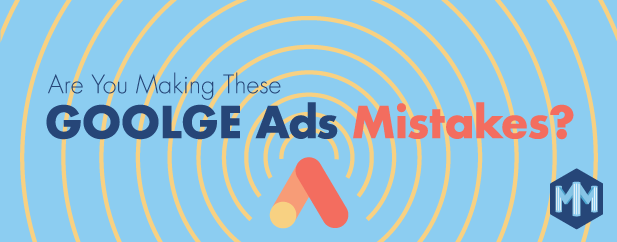Common Google Ads Mistakes

Would you believe me if I told you that SEO and PPC (pay-per-click) are not polar opposites? When you are looking to optimize your Google Ads, you can use both search disciplines to help you see real results. Another way to optimize your Google Ads is to avoid costly mistakes. These mistakes are so common that many Ads accounts have them right from the start. Below I will highlight some of the most common Google Ads mistakes that I see so that you can flag and fix issues before calling in a professional to do it for you.
Too Many Keywords
This is arguably the most common mistake in Google Ads. While Google suggests to make sure your keywords all fall under the same theme, this theme can either be specific or way too broad. If your main theme is too vague, it should be split into multiple ad groups. Try and keep your ad group themes as specific as you can, as this helps you have more control over the ad.
The more control you have over the ad, this means more control over where and what you spend your money on, what your ads look like, what your landing page to ad match is, and more. Even if it means having many more ad groups, trust me, you are going to want to follow my advice. Remember: it is way easier to manage a large number of organized ad groups versus a small number of unorganized ad groups.
Match Type Selection
The next big mistake that many people make is picking the wrong match type. There are four match types that you need to know:
Broad Match: This is the match type that I would recommend using the least. Broad match basically just means that you write out the keyword, and Google will display it for whatever it believes to be relevant in a particular search. This means that if you include one keyword, Google may show your ad in any search with that keyword, regardless of relevancy
Broad Match Modifier (BMM): The BMM is an upgrade from the broad match that includes additional elements. With this type, you put in multiple keywords that can exist in any order and with other words around them, but they all absolutely have to exist in the search.
Phrase Match: Phrase matches are similar to BMM, but they are more restrictive. You can have a keyword phrase with any words before or after, but none in the middle of the phrase. For example, if your phrase was “car dealer” you would match with “used car dealer” but not “car and truck dealer”.
Exact Match: The exact match includes your keywords and nothing else. This is the most specific match type, so you should try it on your most competitive keywords.
I’ve already wrote about how you can waste tons of money on wasted clicks if you’re not using the proper match type.
![]()
Only One Ad Per Group
Next, let’s talk about only having one ad per ad group. I have a few tips for you about ad groups:
a) Try to have at least 3 ads per group. You might think it is easier to manage only one ad per group, but it is actually really hard to see what is working well for you if you have less ads in each group. Have at least 3 ads per group!
b) Bring out emotion in your ad copy. Don’t simply include generic phrases like “our service is the best”, because that isn’t what gets people to call you. Find out what kinds of emotions your clients or team are feeling and use those in your ads! Emotional touches really help your ad to stand out.
c) Include a call to action. People don’t always know that the call to action is the call to click your ad. Including a simple line such as “contact us today” helps the reader understand what they should do when they see your ad. It may seem simple, but it can really improve your results.
d) Use extensions. In Google Ads you will find a section called Extensions. These are small additions to your ad such as having an address show up under an ad, or somebody saying “we’re open 24 hours”. There are many different extensions that you can use, and I’d recommend putting in every extension possible for each ad group. Each extension won’t trigger at the same time, but having them enabled makes them ready to trigger when given the right opportunity. When they do trigger, this gives your ad more prime space and squeezes out the ads of your competitors. This is especially effective on mobile. Just be sure to double check that your filters are set up properly for local extensions!
Separate Display and Search
Finally, always keep display and search separate on Google. Google will automatically want to show your ads everywhere, but you should know that different types of ads work better on the display network versus the search network.
To remain in control of your ad campaign, avoid showing text ads on the display network. Since the search network mainly features text-based ads, it may seem easy to show the same ads on the display network (on websites). But when you do this, you end up with a boring text ad on a website with 10 other ads already on it. Your text ad is not the one that will stand out in this instance. I would consider this a waste of money, and you may end up paying even more if Google labels your group as “bad”. Instead, make sure your display network ads are specially designed for the display network, and leave the text-only ads to the search network.
Any questions about optimizing your Google Ads campaigns? Learn more about our Google Ads campaign management service.
